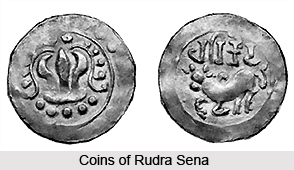 When `Gautamiputra`, the eldest son of Pravar Sena had died, his son Rudra Sena became the king. He was the son of a Bharsiva and hence he was helped by his grand-father-in-law the Bharsivaking Bhavnag. Therefore he naturally came under the influence of the king Bhava Naga. Under his influence he gave up Vaishnav religion and adopted the Shaiva religion of his grand-father-in law. The Vakataka inscriptions refer him as the worshipper of` `Maha-bhairav`.
When `Gautamiputra`, the eldest son of Pravar Sena had died, his son Rudra Sena became the king. He was the son of a Bharsiva and hence he was helped by his grand-father-in-law the Bharsivaking Bhavnag. Therefore he naturally came under the influence of the king Bhava Naga. Under his influence he gave up Vaishnav religion and adopted the Shaiva religion of his grand-father-in law. The Vakataka inscriptions refer him as the worshipper of` `Maha-bhairav`.
Allahabad pillar inscription mentions the name of Rudra Sena among the eight kings who had organized themselves into a confederation against Samudra Gupta. It appears that Rudra Sena I was the leader of this confederation. His defeat at the hands of Samudra Gupta resulted in the loss of some of his provinces. However, many scholars do not agree with this view. They refuse to identify Rudra Sena, mentioned in the Allahabad pillar inscription, with Rudra Sena I.
Rudra Sena I died in about 360 A.D.



















